August 30, 2019
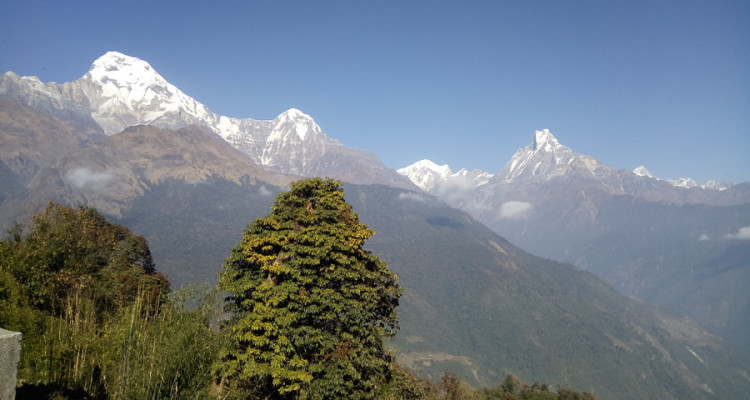
⇒ Ghorepani Poon hill trek Introduction
⇒ Meals and Drinking water during Ghorepani Poon hill trek
⇒ How to get to the starting point of the Ghorepani Poon Hill Trek from Kathmandu
⇒ The History and significance of the Ghorepani Poon Hill viewpoint in trekking culture in Nepal
⇒ Ghorepani Poon hill trekking major Highlights
⇒ Ghorepani-Poon hill Sunrise Trek offers a fantastic introduction to trekking in Nepal
⇒ The beauty and culture of the Annapurna Region and its impact on the trek
⇒ Ghorepani Poon hill trekking weather during October and November
⇒ Tea house Accommodation
⇒ The possibility of extending the Ghorepani Poon Hill Trek to other trails in the Annapurna region
⇒ The diverse landscapes and flora and fauna that one can encounter during the trek
⇒ Ghorepani Poon hill Vs Mardi Himal trek during October and November
⇒ Recommended gear and clothing for the Ghorepani poon hill trek during autumn season
⇒ The role of local guides and porters during the Ghorepani Poon Hill Trek
⇒ Solo trekking vs guided trekking options for Ghorepani poon hill and Ghandruk trek
⇒ The impact of tourism on the local communities and environment in the region
⇒ Beneficial Tips for Ghorepani Poon hill trekking in Oct & Nov
⇒ Ghorepnai Poon hill and Ghandruk trek Distance
⇒ Enjoying the White Mountain views from Ghorepani and Poon Hill
⇒ Comparing Ghorepani Poon Hill Trek with Annapurna Base Camp Trek
⇒ November being a lovely month to travel in Nepal
⇒ Trekking route Information from Ghandruk to Ghorepani During October and November (Autumn Season)
⇒ Difficulty level of the Ghorepani Poon Hill Trek and Preventions
⇒ Ghorepani Poon hill 3 ,4 and 5 days Itinerary from Pokhara
⇒ Health and safety concerns during Ghorepani Poon hill trek
⇒ Ghorepani Poon hill trek during Autumn(Sep.-Nov.) and Spring(March -May)
⇒ Final Conclusion
Ghorepani poon hill trek is for those trekkers who are short on time and passionate to explore the Remote life, Culture and wilderness. No doubt it is one of the most visited short treks in Nepal, which offers you a majestic Annapurna and Dhaulagiri Mountain range.
Also, this short trek takes you from Low Altitude- 850 m up to 3210 m passing so many Local houses, water falls, Rivers, sky touching landscapes and leafy forest of Rhododendron and oak. Therefore, Ghorepani poon hill trek is suitable for all age group travelers as it is rich is wilderness, culture and numerous mountains.
This trek can be done within 3 days now from Pokhara if you are really tight in budget and time.
The Ghorepani poon hill trek is a lower loop holiday of massif Annapurna conservation area(ACAP) so that if you have doubt of acute mountain sickness than be assured it is not kind of trek where you will get hazard of AMS.
Season ways, The Autumn season, September to November and spring, march to May are the best time to trek but if you want to skip the crowd of trekkers than winter and monsoon season will be the great choice of trekking seasons. However, this short 4 days trek can be done during whole year without any obstructions.
Ghorepani is a name local mountain village, covering more than 40 tea houses and located at an altitude of 2875 m, likewise, poon hill is at 3210 m high. In this trek, the temperature will be mild thus, family tour, student tour, trek with kids, aged people, adventure hikers all differences of hikers visit this trip.
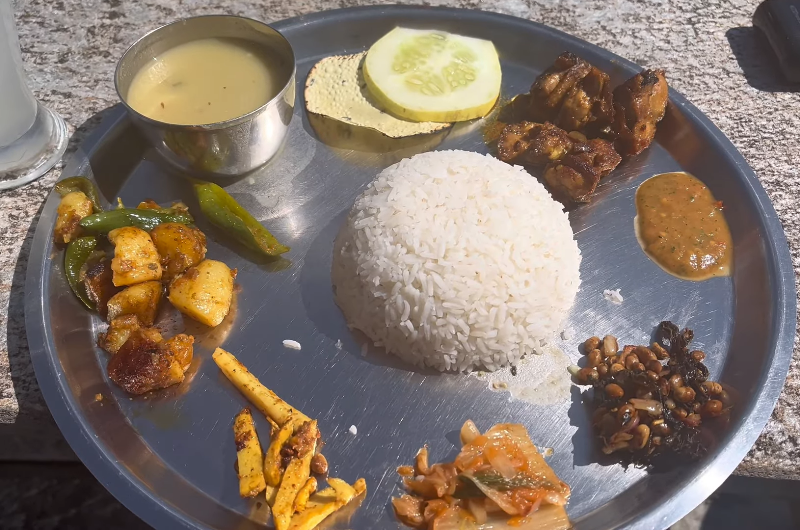
During the Ghorepani Poon Hill trek, you will find a variety of meal options at the tea houses and lodges along the trail. Most tea houses have dining areas where you can enjoy meals throughout the day. The menu typically includes a mix of Nepalese and international dishes. You can expect to find traditional Nepali dal bhat (rice with lentil soup and vegetables), momo (dumplings), noodles, soups, pasta, and even some western-style breakfast options like pancakes or omelets. Keep in mind that as you ascend to higher altitudes, the menu choices may become more limited, and the prices may increase due to the remoteness of the area.
The starting point of the Ghorepani Poon Hill Trek is Nayapul, which is located about 42 kilometers west of the city of Pokhara in Nepal. Here are some ways to get from Kathmandu to Nayapul:
It is important to note that road conditions in Nepal can be challenging and flights are subject to weather conditions, so it’s always best to plan for some extra time and flexibility in your travel arrangements.
The Ghorepani Poon Hill viewpoint is a popular trekking destination in the Annapurna Region of Nepal. The viewpoint, which is situated at an altitude of 3,210 meters, provides stunning panoramic views of the Annapurna and Dhaulagiri mountain ranges, including several peaks that soar over 8,000 meters.
The history of the Ghorepani Poon Hill trek dates back to the time when the ancient trade routes between Nepal and Tibet were established. Merchants used to take this route to trade goods between the two countries, and the trail that passes through Ghorepani was an important stopover point. The Ghorepani Poon Hill viewpoint itself was a popular rest stop for traders and travelers, as it provided an excellent vantage point to view the surrounding mountains.
In modern times, the Ghorepani Poon Hill trek has become an iconic part of trekking culture in Nepal. It is considered one of the best short treks in the Annapurna region and is popular among trekkers of all ages and experience levels. The trek typically takes four to five days to complete and offers a unique blend of natural beauty, cultural immersion, and adventure. The Ghorepani Poon Hill viewpoint remains a highlight of the trek, offering trekkers a chance to witness one of the most stunning mountain vistas in the world. Its significance to the trekking culture in Nepal continues to draw thousands of visitors to the region each year.
The Ghorepani-Poonhill Sunrise Trek is indeed considered one of the most popular and best short treks in Nepal. It is a relatively short trek, typically taking around 5-7 days to complete, making it ideal for those with limited time or for those who are new to trekking.
The trek takes you through charming villages, lush forests, and offers stunning views of the Annapurna and Dhaulagiri mountain ranges. The highlight of the trek is the sunrise view from Poon Hill, which is considered one of the best vantage points in Nepal for viewing the Himalayan peaks.
The trek is also relatively easy, making it accessible to a wide range of travelers, including families with children and those with limited trekking experience. The trail is well-established, and there are ample teahouses and lodges along the way, providing comfortable accommodation and delicious local food.
Overall, the Ghorepani-Poonhill Sunrise Trek offers a fantastic introduction to trekking in Nepal, with stunning views, comfortable accommodation, and a manageable itinerary. It is no surprise that it has become one of the most popular and highly recommended short treks in Nepal.
The Annapurna Region of Nepal is renowned for its stunning natural beauty and rich cultural heritage, making it one of the most popular trekking destinations in the world. With its towering snow-capped peaks, lush forests, picturesque villages, and diverse flora and fauna, the region is a haven for nature lovers and adventure seekers alike.
The impact of this beauty and culture on the trek cannot be overstated, as it adds to the overall experience and creates a sense of awe and reverence for the region. The trek takes visitors through a range of landscapes and elevations, allowing them to immerse themselves in the unique culture and customs of the local communities. The people of the Annapurna region are warm and hospitable, and their traditions and customs have remained largely intact despite the influx of tourism in recent years. Overall, the beauty and culture of the Annapurna Region make for a truly unforgettable trekking experience.
If you plan to go trekking or hiking in Nepal, the best time to visit is during October and November. This applies to the Ghorepani Poon Hill trek as well. Although the mornings and evenings may be chilly, it’s not unbearably cold. By afternoon, you can comfortably walk in shorts and a t-shirt. Only on days 2 and 3 will it be slightly colder, but overall, the temperature during these months is perfect under the clear blue sky.
If you’re staying in settlements on days 2 and 3, you can warm up in the dining hall with a wood stove, and at night, the lodges provide cozy blankets. Based on feedback from past guides, porters, and trekkers, we’ve determined the approximate temperatures for each settlement.
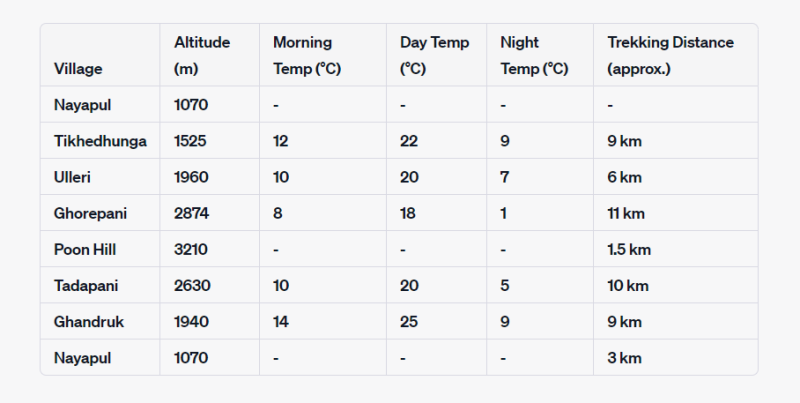
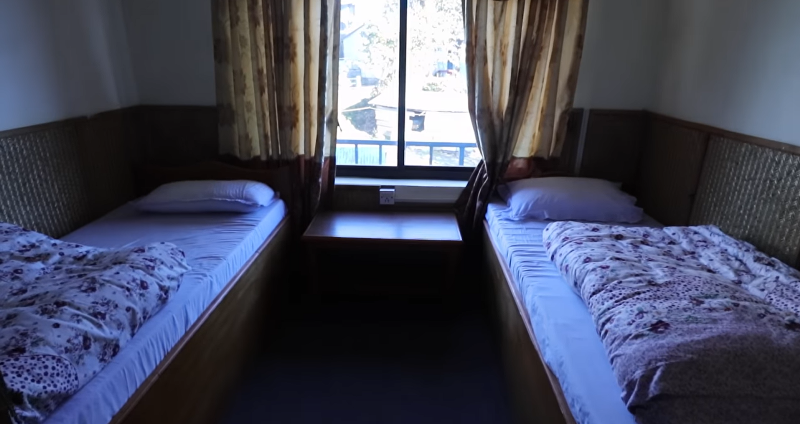
During the months of October and November, the Ghorepani Poon Hill trek is a popular tourist destination, making it very busy and crowded. It’s highly recommended to reserve accommodation in advance before reaching your destination each day to avoid any inconvenience.
While the rooms are relatively small in size compared to city hotels, there is still enough space for sleeping and storing your luggage. Typically, twin beds are provided, but upon request, additional beds may be added if there’s space in the room, which can be shared with friends. Most tea houses along the trek are made of wood, but in recent years, a few modern concrete buildings with attached bathrooms have been constructed, although only a handful of lodges offer this service.
It’s important to note that charging electrical devices is not available in the rooms, so it’s best to inquire with the hotel manager about where to charge and the cost of charging.
If you plan on following the 4-night, 5-day itinerary for the Ghorepani Poon Hill trek, it’s worth noting that better accommodation can be found on the second day at Ghorepani and the fourth day at Ghandruk, compared to the other two nights.
The cost of tea house accommodation on the Ghorepani trek is relatively inexpensive, but there have been some variations in prices in recent years. In general, the cost of a twin bed room ranges from around $3 to $15 US.
It is possible to extend the Ghorepani Poon Hill Trek to other trails in the Annapurna region. Some popular options include:
Annapurna Base Camp Trek: This is a longer trek that takes around 10-14 days to complete. The trail leads through beautiful rhododendron forests and passes through several traditional Gurung and Magar villages before reaching the Annapurna Base Camp.
Mardi Himal Trek: This is a less-traveled trek that takes around 5-7 days to complete. The trail is less strenuous than the Annapurna Base Camp trek but offers stunning views of the Himalayas and passes through traditional villages and forests.
Jomsom Muktinath Trek: This is a popular trek that takes around 7-10 days to complete. The trail passes through the Kali Gandaki valley and offers stunning views of the Annapurna and Dhaulagiri ranges. The trek also includes a visit to the holy site of Muktinath.
All of these treks require a good level of fitness and proper acclimatization, and it is recommended to go with a guide or a trekking agency for safety and convenience. These extensions can add an extra layer of adventure and exploration to your Ghorepani Poon Hill trek and allow you to experience the diverse landscapes and cultures of the Annapurna region.
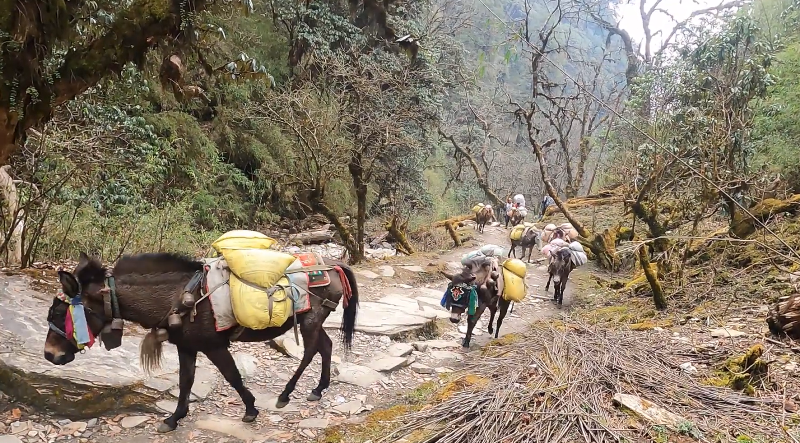
Suppling the Goods on Donkeys’
The Ghorepani Poon Hill Trek in the Annapurna Region of Nepal offers trekkers a chance to experience diverse landscapes and encounter unique flora and fauna. Here are some highlights of what trekkers can expect to see during the trek:
Overall, the Ghorepani Poon Hill Trek offers a unique opportunity to experience the diverse landscapes and flora and fauna of the Annapurna Region of Nepal.
Both the Ghorepani Poon Hill Trek and the Mardi Himal Trek are popular trekking routes in the Annapurna region of Nepal, and both are great options to trek during October and November.
The Ghorepani Poon Hill Trek is a shorter trek, typically taking around 5-7 days to complete. The trek takes you through charming villages, lush forests, and offers stunning views of the Annapurna and Dhaulagiri mountain ranges. The highlight of the trek is the sunrise view from Poon Hill. This trek is generally considered easier than the Mardi Himal Trek, and it is more suitable for those who are new to trekking.
The Mardi Himal Trek is a relatively new trekking route in the Annapurna region, taking around 7-10 days to complete. The trek takes you through a variety of landscapes, including rhododendron forests, high-altitude pastures, and rocky terrain, offering stunning views of the Annapurna range, Machhapuchhre (Fishtail), and Mardi Himal. This trek is generally considered more challenging than the Ghorepani Poon Hill Trek, and it is more suitable for experienced trekkers.
Overall, both treks offer unique experiences and stunning views of the Himalayas. The choice depends on the level of difficulty that one is willing to undertake and the time available. If you’re new to trekking or have limited time, the Ghorepani Poon Hill Trek is a great option. If you’re an experienced trekker and want a more challenging trek with stunning views of the Annapurna range, the Mardi Himal Trek is a great option.

During this short trekking, one of the most commonly searched topics is trekking equipment. People want to know what to wear during the trek, what to bring, and what to avoid. Interestingly, the season doesn’t affect the clothing choices much as the temperature remains relatively constant throughout the year. However, if you plan to trek in December and January, it’s advisable to bring warm clothes, and if you plan to trek during the monsoon season (June to August), rain covers and coats are a must-have.
Having years of trekking experience, we recommend you bring the following list of trekking equipment for Ghorepani Poon Hill trekking in October and December:
Note: If you are a city girl, you may be used to carrying items such as a hair dryer, makeup box, and city dresses. However, when trekking in the mountains, it can be challenging to use these items due to the cold weather and limited electrical power. As such, it is recommended that you leave these items in Pokhara for a few days.
Local guides and porters play a crucial role in the success and safety of trekkers during the Ghorepani Poon Hill Trek. Guides, who are typically local to the region, provide invaluable knowledge about the terrain, weather, and cultural significance of the area. They can also assist with navigation and provide insights into the local flora and fauna. Porters, on the other hand, carry heavy equipment and supplies for trekkers, easing the physical burden on hikers and allowing them to enjoy the trek more fully. Both guides and porters are an essential part of the trekking experience and contribute significantly to the local economy.
Both solo trekking and guided trekking options are available for the Ghorepani Poon Hill and Ghandruk trek, and the choice ultimately depends on your personal preference and experience level.
Solo trekking can be a rewarding experience for experienced hikers who are comfortable navigating the trail on their own. It offers a lot of flexibility and allows you to trek at your own pace and on your own schedule. However, it also requires careful planning and preparation, as well as the ability to handle any unexpected situations that may arise.
Guided trekking, on the other hand, provides you with the expertise and knowledge of a local guide who knows the trail well. This can enhance your overall experience by providing insights into the local culture, flora and fauna, and history of the region. A guide can also ensure that you stay safe and on track throughout the trek. Additionally, guided trekking can provide a sense of security and companionship during the trek.
Ultimately, the decision between solo and guided trekking depends on your level of experience, comfort with the trail, and personal preference. If you are a first-time trekker or unsure about the trail, a guided trek may be the best option. However, if you are an experienced hiker and prefer a more independent experience, solo trekking may be the way to go.
Tourism has had a significant impact on the local communities and environment in the Annapurna Region of Nepal, including during the Ghorepani Ghandruk Trek in the autumn season. On one hand, tourism has brought economic benefits to the local communities by creating job opportunities in the hospitality and service industries. However, it has also led to increased pressure on natural resources, environmental degradation, and cultural changes.
The influx of tourists has resulted in increased demand for food, water, and energy, leading to the overuse of natural resources. The construction of new hotels, lodges, and roads has also had an impact on the environment. In addition, the exposure to different cultures and lifestyles has led to changes in the traditional way of life of local communities. It is important for the tourism industry to be mindful of these impacts and work towards sustainable tourism practices to minimize negative effects on the environment and culture of the region.
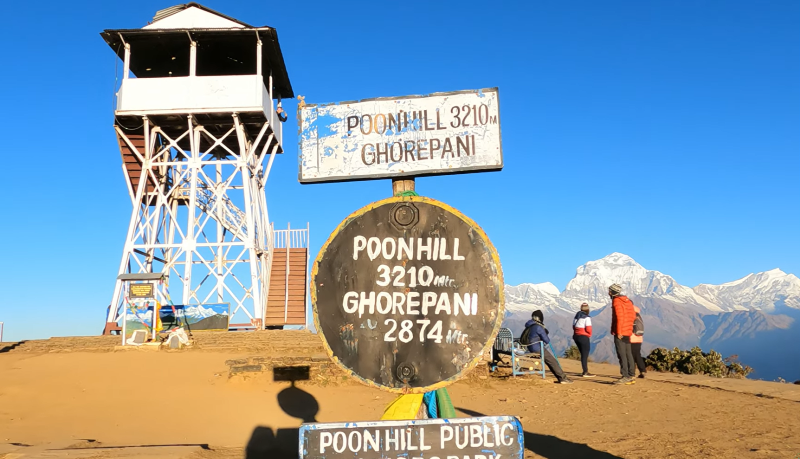
At Poon hill view point at 3210m
The total distance of the Ghorepani Poon Hill and Ghandruk Trek in Nepal varies depending on the specific route taken by trekkers. Generally, the trek covers a distance of around 40-50 kilometers (25-31 miles) over a period of 4-5 days.
The trek begins in Nayapul, and the first day’s walk covers a distance of approximately 9 kilometers (5.6 miles) to reach Tikhedhunga. The second day’s trek from Tikhedhunga to Ghorepani is around 12 kilometers (7.5 miles) long. On the third day, trekkers hike from Ghorepani to Poon Hill and then to Tadapani, covering a distance of around 14-15 kilometers (8.7-9.3 miles). Finally, the fourth day’s trek from Tadapani to Ghandruk is around 10-11 kilometers (6.2-6.8 miles). The final day involves a descent from Ghandruk to Nayapul, covering around 5-6 kilometers (3.1-3.7 miles) before concluding the trek.
Ghorepani and Poon Hill offer breathtaking views of the snow-capped peaks of the Himalayas. From here, you can see Dhaulagiri (8,167m), Annapurna South (7,219m), Fishtail (6,993m), Hiunchuli (6,441m), and other peaks. The white-capped mountains stand tall against the blue sky, and the view is simply awe-inspiring. The snow-capped peaks glisten in the sunlight, and the serene beauty of the mountains is a sight to behold. If you’re a nature lover or a mountain enthusiast, the views from Ghorepani and Poon Hill are a must-see.
Both the Ghorepani Poon Hill Trek and Annapurna Base Camp Trek are popular trekking routes in the Annapurna region of Nepal.
The Ghorepani Poon Hill Trek is a relatively shorter trek, taking around 5-7 days to complete. It is suitable for those who want to experience the beauty of the Himalayas in a shorter period of time. The trek takes you through charming villages, lush forests, and offers stunning views of the Annapurna and Dhaulagiri mountain ranges.
On the other hand, the Annapurna Base Camp Trek is a longer trek, taking around 7-12 days to complete. It is a more challenging trek that takes you through diverse landscapes, including rice paddies, forests, and high-altitude mountain terrain. The trek culminates at Annapurna Base Camp, which offers a panoramic view of the Annapurna massif.
Both treks offer unique experiences and stunning views of the Himalayas. The choice depends on the time available and the level of difficulty that one is willing to undertake.
November is indeed a lovely month to travel in Nepal, especially for those who prefer to avoid the crowds of peak tourist season. October is generally considered the peak tourist season in Nepal, and while the weather is still favorable in November, the number of tourists tends to drop off.
During November, the weather in Nepal is generally mild and dry, with clear skies and warm days. The monsoon season has come to an end, and the air is fresh and clear, making it an excellent time for trekking and outdoor activities.
Moreover, November is also a great month to experience Nepal’s culture and festivals, including the popular Tihar or Diwali festival, which is celebrated with colorful lights, music, and dance.
Overall, November is a fantastic time to visit Nepal, offering great weather, fewer crowds, and a chance to experience the country’s unique culture and festivals.
The trekking route from Ghandruk to Ghorepani is a beautiful and scenic trail that takes you through charming villages and lush forests. After about 2 hours of walking from Ghandruk, you will reach Bhaishikharaka, a small village with beautiful views of the Annapurna range. From here, it’s another hour’s walk to Tadapani, another small village with a few teahouses.
Continuing along the trail, you will enter a dense rhododendron forest, and there are no teahouses along the way for about 2 hours until you reach Deurali. This section of the trail is known for its stunning natural beauty and is a highlight of the trek. At Deurali, there is a teahouse where you can rest and enjoy a warm meal.
From Deurali, there is a short climb up to Gurung Hill, which offers some of the best views of the Annapurna and Dhaulagiri mountain ranges. It’s a great spot to take in the stunning scenery and take some photos. From Gurung Hill, it’s a 40-minute descent to Ghorepani, where you can find several teahouses and lodges for accommodation.
Overall, the trekking route from Ghandruk to Ghorepani is a relatively easy trek, with a few steep sections and some beautiful views along the way. It’s a great option for those who want to experience the beauty of the Annapurna region without committing to a longer trek. The route takes you through several charming villages, dense forests, and offers stunning views of the Himalayas.
The Ghorepani Poon Hill Trek is considered a moderate-level trek, suitable for most people with a good level of fitness. The trail is well-maintained and there are teahouses along the way where you can rest and recharge. The highest point of the trek is Poon Hill, which is at an altitude of 3,210 meters (10,531 feet).
However, as with any trek, it’s important to prepare yourself physically and mentally to ensure a safe and enjoyable experience. Here are some tips to help you prepare for the Ghorepani Poon Hill Trek:
By following these tips and preparing well, you’ll be ready to tackle the Ghorepani Poon Hill Trek with confidence and enjoy the stunning beauty of the Annapurna region.
The Ghorepani Poon Hill Trek is a popular trekking route in the Annapurna Region of Nepal. There are different itinerary options available for trekkers depending on their time constraints and fitness level. Here are three possible itineraries for the Ghorepani Poon Hill Trek from Pokhara:
3-day Itinerary:
Day 1: Drive from Pokhara to Nayapul and trek to Tikhedhunga
Day 2: Trek from Tikhedhunga to Ghorepani and climb to Poon Hill for sunrise view
Day 3: Trek from Ghorepani to Nayapul and drive back to Pokhara
4-day Itinerary:
Day 1: Drive from Pokhara to Nayapul and trek to Tikhedhunga
Day 2: Trek from Tikhedhunga to Ghorepani
Day 3: Climb to Poon Hill for sunrise view and trek to Tadapani
Day 4: Trek from Tadapani to Ghandruk and drive back to Pokhara
5-day Itinerary:
Day 1: Drive from Pokhara to Nayapul and trek to Tikhedhunga
Day 2: Trek from Tikhedhunga to Ghorepani
Day 3: Climb to Poon Hill for sunrise view and trek to Tadapani
Day 4: Trek from Tadapani to Ghandruk
Day 5: Trek from Ghandruk to Nayapul and drive back to Pokhara
Note: The actual trekking distance and duration may vary depending on the specific route, trekking pace, and weather conditions.
The Ghorepani Poon Hill Trek is generally considered a moderate trek and is suitable for trekkers of all ages and fitness levels. However, like any trek, there are certain health and safety concerns to keep in mind, especially during the autumn season (September to November) when the trek sees a high number of visitors.
One of the main health concerns during the trek is altitude sickness, which can occur at higher elevations. It is important to acclimatize properly by gradually ascending and staying hydrated. Trekkers should also be prepared for cold weather and carry appropriate clothing and gear.
Safety concerns include potential risks on the trail such as slippery paths, landslides, and avalanches. Trekkers should also be cautious of wild animals like leopards and bears. Hiring a local guide and porter can help mitigate these risks and ensure a safe and enjoyable trekking experience.
The Ghorepani Poon Hill Trek is a popular trekking route in the Annapurna Region of Nepal, and it can be done in both the autumn (September to November) and spring (March to May) seasons. Both seasons have their own advantages and challenges. Here are some differences between the two seasons:
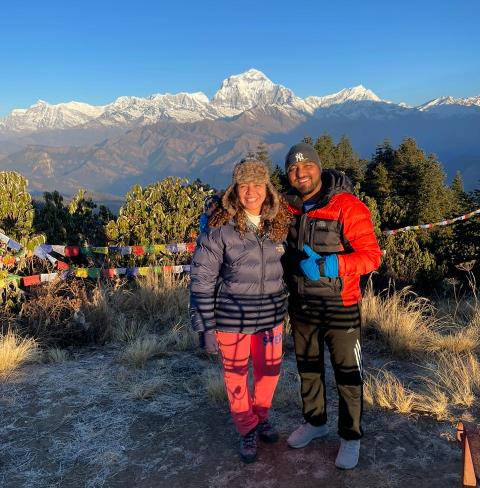
View from Poon hill view tower
Autumn Season:
Spring Season:
Overall, both seasons are great for the Ghorepani Poon Hill Trek, but autumn is the most popular season due to the clear mountain views and favorable weather conditions. However, spring can be a great choice for those who prefer a quieter trekking experience and enjoy seeing the beautiful blooms of the season.
The Ghorepani Poon Hill trek in the Annapurna region is undoubtedly one of the finest short treks available. Poon Hill is the second most popular viewpoint in Nepal after Kalapathar, and this trek offers a wealth of stunning sights and experiences. From encountering diverse ethnic communities and witnessing remote lifestyles to enjoying panoramic views of towering mountains, lush green hills, and untouched wilderness, this trek has it all.
For the best experience, it is recommended to embark on the Ghorepani trek in October and November or from March to May. However, if you prefer a more peaceful and quiet environment, you can choose any other month of the year to enjoy this trek amidst serene surroundings.